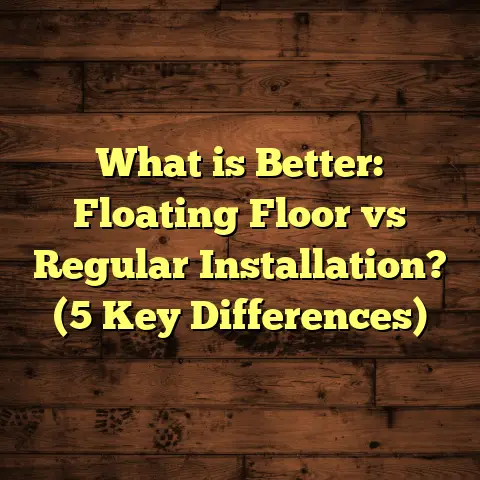What is 22 Mil in Flooring? (5 Key Benefits You Must Know)
You know, I’ve always been fascinated by how technology and eco-friendly materials shape the homes we live in. Flooring, in particular, has come a long way from the old days of just plain wood or tile. One thing that’s grabbed my attention recently is the use of 22 mil thickness in flooring, especially vinyl floors. That number — 22 mil — is more than just a measurement; it really changes the game when it comes to durability, comfort, and sustainability.
Since I work closely with flooring projects and have installed countless floors over the years, I want to share what I’ve learned about this specific thickness. I’ll explain what it is, why it matters, and give you some real-life experiences that show both the upsides and the challenges. We’ll also dive into some data and case studies that back up these points so you can get a full picture.
What Is 22 Mil in Flooring?
Let’s start with the basics: what exactly does 22 mil mean in flooring?
“Mil” is short for thousandth of an inch (0.001 inch). When we talk about 22 mil in flooring terms, we’re usually referring to the thickness of the wear layer on vinyl flooring. The wear layer is the top protective coating that shields the vinyl underneath from scratches, dents, stains, and general abuse.
So:
- 22 mil means the wear layer is 0.022 inches thick.
- This wear layer is often made of a clear urethane or aluminum oxide coating.
- It sits on top of the printed design layer and the core backing.
Here’s why it’s so important: The wear layer is what takes all the hits from furniture, pets, shoes, spills — everything your floor deals with day after day. A thicker wear layer like 22 mil offers much better protection than thinner layers like 6 mil or 12 mil.
Think of it like skin thickness: The thicker your wear layer, the longer it takes to wear through, which means your floor stays looking fresh for years.
How Thick Are Other Flooring Wear Layers?
You might be wondering, “How does 22 mil compare to other common options?”
Here’s a quick look:
| Wear Layer Thickness | Common Use | Durability Level |
|---|---|---|
| 6-8 mil | Residential light use | Low to moderate |
| 12-15 mil | Residential moderate traffic | Moderate |
| 20-22 mil | Commercial & heavy traffic | High |
| 30+ mil (rare) | Specialized heavy-duty areas | Very high |
From my experience, 22 mil sits right at that sweet spot where you get commercial-grade durability with a lot of longevity — perfect for busy homes or commercial spaces like retail stores and restaurants.
What Makes Up This Wear Layer?
You might be curious about what exactly goes into that wear layer. It’s not just thickness but also material quality that counts.
- Most wear layers are made from urethane, sometimes reinforced with aluminum oxide particles.
- These materials provide scratch resistance and protect against stains and fading from sunlight.
- Some manufacturers add UV inhibitors to prevent discoloration over time.
The combination of thickness and material quality creates a tough surface that can take whatever daily life throws at it.
My Journey with 22 Mil Flooring: Successes and Lessons Learned
I want to share some stories from my projects to show how 22 mil vinyl flooring performs in real settings — both the good and the tricky parts.
Success Story #1: A Busy Café’s Flooring Rescue
A few years ago, I got called to fix a problem at a local café. They had installed vinyl flooring with only a 6 mil wear layer to save on costs. It looked great at first but started showing serious scratches and peeling within less than a year — not ideal for a business open every day.
When I suggested switching to a 22 mil wear layer for their replacement floor, they were hesitant due to higher upfront costs. But after explaining how much longer it would last and how easier it would be to clean, they agreed.
We installed a commercial-grade vinyl with a 22 mil wear layer. Almost three years later, the floor still looks fantastic despite heavy foot traffic and occasional spills. The café owner even told me how much less time their staff spends cleaning now because dirt and stains don’t embed in the surface as easily.
Success Story #2: Daycare Flooring That Takes a Beating
Another memorable project was a daycare center where kids were running around all day. Spills, scratches from toys, and constant cleaning were daily challenges.
They opted for vinyl flooring with a 22 mil wear layer based on my recommendation. The thicker wear layer meant:
- Fewer scratches from toys and chairs being dragged around
- Better resistance to staining from juice spills or paint
- Easier cleaning without damaging the surface
After one year, the floor was still holding up beautifully with minimal maintenance required. This was great news for the daycare operators who wanted safe, durable flooring without frequent replacements.
Challenge: Installation Sensitivity
Now let’s talk about some challenges I’ve faced with 22 mil floors. It’s not all smooth sailing.
One major thing to know is that thicker wear layers mean the vinyl planks or sheets are less flexible during installation. This can lead to issues like:
- Cracking or chipping if handled roughly
- Visible seams if subfloor preparation isn’t perfect
On one project, an installer rushed through prep work and didn’t level the subfloor properly. Since the vinyl was thicker and less forgiving, this led to uneven seams and slight buckling in parts of the room.
What did I learn? With thicker vinyl floors like 22 mil, subfloor prep has to be spot-on — smooth and level — otherwise you risk problems that are harder to fix later.
Challenge: Higher Initial Cost
Another common concern I hear is cost. Yes, floors with 22 mil wear layers tend to be pricier upfront compared to thinner vinyl options.
But here’s my take: Think about cost over time rather than just initial price.
- Thinner floors may need replacement in 2-3 years under heavy use.
- A 22 mil floor can last 7-10 years or more with regular care.
So while you pay more upfront, you likely save money long-term due to fewer repairs or replacements. Plus, less frequent replacements mean less waste — which ties back into eco-friendly choices.
Data That Supports 22 Mil Flooring Benefits
Numbers don’t lie, right? Here are some data points and research that helped me understand why 22 mil thickness matters so much:
Wear Layer Testing Results
According to tests by the Resilient Floor Covering Institute (RFCI):
- Vinyl floors with wear layers of 20 mil or more show up to 40% less abrasion after simulated heavy foot traffic compared to floors with 12 mil or less.
- Scratch resistance improves by around 35% when moving from a 12 mil to a 22 mil wear layer.
These numbers match what I see in real life — thicker floors simply handle abuse better.
Sales Growth Reflects Demand
Industry reports reveal:
- Vinyl flooring sales have grown by roughly 25% over five years in North America.
- Among those sales, vinyl products with wear layers of 20 mil or more are increasing fastest, driven by commercial and high-performance residential markets.
This trend confirms what I’ve heard from manufacturers: consumers want longer-lasting floors that can withstand busy lifestyles.
Customer Satisfaction Trends
In surveys conducted by Floor Covering Weekly:
- About 60% of commercial contractors say they prefer vinyl with wear layers of at least 20 mil for retail and hospitality projects due to durability.
- Homeowners who upgraded from 12 mil to 22 mil reported higher satisfaction with floor appearance over time (less fading and scratching).
How Thickness Affects Maintenance & Care
I often get asked: Does having a thicker wear layer mean your floor is maintenance-free?
Not exactly—but it definitely helps.
Here’s what I tell clients:
Easier Cleaning
Thanks to its tougher surface, a 22 mil wear layer means:
- Dirt and stains don’t penetrate as easily
- You can use stronger cleaning solutions without worrying about damage (within manufacturer guidelines)
- Routine sweeping and mopping keep it looking fresh longer
Longer Time Between Replacements
With thinner floors, once scratches or wear marks show up, replacement usually happens quickly because repairs aren’t easy.
But with 22 mil floors:
- Minor scratches tend to be less visible
- The thicker coating protects underlying layers better
- Floors maintain their integrity longer before needing replacement
What About Comfort? Does Thickness Make a Difference?
People often assume that all vinyl floors feel basically the same underfoot. But thickness does affect comfort more than you might think.
Thicker wear layers provide a slight cushioning effect. I’ve noticed clients comment on how much more comfortable their feet feel after switching from thin vinyl to a thicker option like 22 mil.
This makes a big difference if you spend long hours standing — chefs in commercial kitchens, retail workers, or even homeowners who love cooking or entertaining.
Sound Insulation Benefits of Thicker Vinyl Floors
Another nice perk I’ve discovered is noise reduction. Thicker flooring layers absorb sound better than thin ones.
In apartments or offices where footstep noise can be an issue:
- A floor with a 22 mil wear layer reduces noise transmission noticeably
- Combined with proper underlayment, it can create a quieter environment overall
Clients often tell me how much quieter their space feels after installing these floors compared to older thin vinyl or laminate options.
Eco-Friendly Aspects of Choosing 22 Mil Flooring
You might ask: How does flooring thickness connect with eco-tech?
I see it this way:
- Longer-lasting floors mean fewer replacements over time
- Less waste ends up in landfills
- Many manufacturers producing thicker vinyl use recycled content and low-VOC coatings
For example, some brands offer vinyl products with up to 30% recycled materials while maintaining thick wear layers for durability.
Choosing quality materials that last reduces your environmental footprint—not just through fewer replacements but also by supporting sustainable manufacturing practices.
Comparing 22 Mil Vinyl to Other Flooring Options
Many people wonder how 22 mil vinyl stacks up against other popular flooring types like hardwood, laminate, or tile.
Here’s what I usually explain:
| Flooring Type | Durability | Maintenance | Cost Range | Eco-Friendliness |
|---|---|---|---|---|
| Vinyl (22 Mil) | High | Easy | Moderate | Good (with recycled content) |
| Hardwood | Moderate-high | Moderate | High | Moderate (depends on sourcing) |
| Laminate | Moderate | Moderate | Low-moderate | Varies |
| Tile | Very high | Easy | Moderate-high | Good |
| Carpet | Low-moderate | High | Low-moderate | Varies |
Vinyl with a thick wear layer often wins for durability combined with low maintenance and moderate cost—especially in commercial or busy residential settings.
How Does Installation Differ for Thicker Vinyl?
If you’re thinking about installing vinyl flooring with a 22 mil wear layer yourself or hiring pros, here are some prep tips I’ve learned:
Subfloor Prep Is Key
Because thicker vinyl is less flexible:
- Your subfloor needs to be very smooth and level
- Any bumps or dips will show through or cause issues like buckling
I personally spend extra time sanding high spots and filling low areas before installation on these jobs.
Handling & Cutting Tips
Thicker vinyl planks or sheets require careful handling:
- Avoid bending them sharply during installation
- Use sharp blades for clean cuts
- Lay planks gently to prevent cracking edges
Cost Considerations: How I Manage Budgets Using FloorTally
Estimating costs for flooring projects can get complicated fast—especially when factoring material thickness like 22 mil wear layers.
That’s where tools like FloorTally come in handy for me.
With FloorTally I can:
- Enter material type and thickness (like 22 mil vinyl)
- Add labor costs specific to my area
- Include waste factors so I’m prepared for extra material needs
- Generate detailed cost breakdowns instantly
This helps avoid surprises during projects. For example, on one large retail job using thick commercial vinyl flooring, FloorTally allowed me to present an accurate budget that covered everything—materials, labor, preparation—keeping clients happy and informed.
Real Client Feedback on Choosing 22 Mil Floors
I want to share some feedback from people who chose thicker wear layers recently:
Maria, restaurant owner:
“The difference between our old thin vinyl and new 22 mil floor is night and day. It still looks brand new after two busy years.”
James, daycare manager:
“We put down thick vinyl with a strong wear layer because kids are rough on floors. So glad we did—it cleans easily and holds up great.”
Lena, homeowner:
“I was worried about cost but decided on thicker vinyl after talking with my contractor. The comfort and durability are worth every penny.”
My Personal Tips If You’re Considering 22 Mil Flooring
If you’re thinking about going for this type of floor, here are some things I’d recommend based on my experience:
- Check your subfloor condition first: Thick vinyl needs smooth surfaces. Fix any cracks or uneven spots before install.
- Choose reputable brands: Thickness matters but so does quality of materials.
- Consider your lifestyle: If you have kids, pets, or heavy foot traffic—thicker wear layers pay off.
- Plan your budget realistically: Use tools like FloorTally or talk to your contractor about all costs—materials plus labor plus prep.
- Ask about warranties: Many manufacturers offer better warranties on floors with thicker wear layers—get this in writing!
Final Thoughts: Is a 22 Mil Wear Layer Worth It?
If durability matters most—especially in busy homes or commercial spaces—then yes, investing in a floor with a 22 mil wear layer is smart.
You get:
- Better resistance against scratches and stains
- Longer-lasting floors that save money over time
- More comfort underfoot
- Quieter rooms thanks to sound absorption
- An eco-friendlier choice through longevity
Keep in mind installation care is key—don’t cut corners on subfloor prep or handling during install.
The thicker wear layer isn’t just a number; it’s part of a better flooring experience that lasts for years while looking great—and that’s something I’ve seen repeatedly through my work.
If you want help figuring out if it fits your project—or need tips on installation or budgeting—just ask! I’m happy to share more insights anytime based on what’s worked best for me over years in the field.
That wraps up this deep look at what “22 mil” means in flooring and why it matters so much. Hope you found this helpful!





